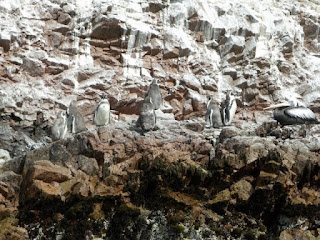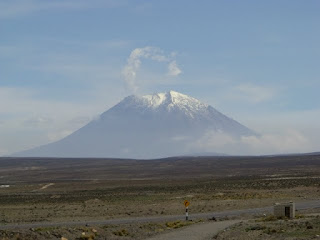Well we had to leave the Galapagos Islands at some point and it was a real wrench, but we had a great Christmas and New Year in very good company.
So we departed the Galapagos on the 2nd of Jan; stopped in Quito for two nights at the Mia Leticia (again) and then caught a flight out of Quito on the 4th Jan to LIma; sounds easy doesn't it, but landing in Quito was like being thrown into a bun fight. 4 flights landed together and there were only two carousels in the baggage reclaim. There were bags everywhere, as well as people. It took mnearly 40 minutes to get our bags back. But we survived.
Anyway back to Lima: We have seen the colonial offerings of Lima before, churches, houses museos etc, as well as some of the pre-inca sites, e.g. Pachacamac. So we decided to stay one night and move on to places we hadn't been to.
PARACAS and the BALLESTAS ISLANDS
Paracas was first on the list. This is famous for its Pre-Inca culture, surprisingly called Paracas Culture. Very colourful ceramica and textiles, but the museum (Julian Tello Museo) was being rebuilt!!! so we visted the Paracas National Park and the Ballestas Islands.
Paracas was and still is a busy fishing port:
 |
| Yep plenty of fishing boats there... |
The Ballestas Islands are just off shore, and are full of birds, guano and of course sea lions:
 |
| ...Pelicans and Peruvuan boobies (stop it!)...which one is which |
 |
| Humboldt penguins.... |
 |
| Sea lions are surprisingly good at rock climbing.... |
 |
| ...and all that guano is chipped off every 5 or 8 years for sale as fertiliser... |
 |
| oh, and don't forget the cormorants... |
The land from Lima down to Arequipa is arid sandy desert, where you will be hard pressed to find anything growing, but the coast is teaming with life. The Paracus National Park is a good example of how arid, but beautiful this type of terrain can be:
 |
| El Candelabro, cut into the volvanic tufa and sand, by whom?.....500m tall |
 |
| You know that arid desert coastline I talked about.....this is what its like...for hundreds of miles.... |
 |
| ..the road into the Paracas National Park..its not tarmac, just compressed salt..... |
 |
| ..here's a closer look at the tufa, fossil shells, which means.... |
 |
| ..we must be near the coast, which is quite beautiful, if a little on the warm side... |
 |
| ...the locals harvest the sargasso seaweed which is washed up on shore... |
 |
| ...but life is still tough for some locals... |
 |
| ...anyone recognise this beach???? |
 |
| or this one?? Both of these were used in the original Film of Planet of the Apes with Charlton Heston ( c 1976/77) |
 |
| ...Morecambe Bay we hear you say, but no we're talking Paracas....where there are some Flamingos.... a long way off |
After two days in Paracas we caught the bus to....
ICA and HUACACHINA
Ica is the wine producing capital of Peru, but we didn't have time for gettting bladdered, sorry we mean a wine tasting tour, because we stayed in a quiet oasis called Huacachina, which is nestled in amongst some big sandunes (250 metres tall).
Here we walked around the tropical lagoon famed for its healing waters... which are very green...and which you can't swim in
 |
| ..See what we mean about those sand-dunes... huge and there's only one thing to do on sand-dunes that big... |
|
 |
| ands that's to take a sand buggy ride...for a few miles.... |
 |
| ...to go sandboarding down the dunes.... |
 |
| ...which stretch for miles and miles... |
 |
| Huacachina oasis from the first range of dunes...Ica is just behind the one in the distance... |
|
So we had our fun here, and were carrying sand in our pockets for the next few weeks. Next stop Nasca....
NASCA
Hmm, OK we are not talking about NASCAR, loosely described as motor racing followed by some petrol heads. No we are talking about the Nasca desert and its man made lines.
These were discovered during the 1920's and 30's when the first commercial flights were made above the desert. This interested a german mathematician and geographer (Maria Reiche) who made it her life's work (from 1933 until 1998, Maria was 95 when she died) to survey, document and record every single line and figure that had been left by the ancient peoples, known surprisingly as the Nasca Culture, who lived in this arid region.
The detailed purpose of the lines may never be known, but it has been deduced that 30% of the lines, indicate locations of water sources. A percentage of lines indicate routes or paths across the desert from one settlement to the next, but some markings defy such explanations, such as the animal figures and the trapezoids.
The desert consists of a layer of red oxidised stone overlaying a grey sandy sublayer..
 |
| ..you see red rocks everywhere... |
 |
| but if you just remove them there is a lighter layer underneath...simple really. |
|
The best way to see the lines is from the air so we booked a flight. The figures are highly stylised:
 |
| OK can you see the monkey here..had to adjust the contrast heavily.. |
 |
| Can you see the whale? |
|
 |
| ..and this is a condor.... |
|
|
 |
| ...the lines are complex and some travel for 50 kms... |
|
Obviously the lines were not constructed by the same people who ripped up the road outside our hostel...
Sorry but have to move the blog along; If you are interested in more pictures and a little history then take a look at this link
Nasca Lines.
AREQUIPA
Arequipa is an old spanish colonial town which has retained a lot of its original architecture thanks to single storey building policies of the early spanish administration. However the cathedral in the Plaza des Armas has been devastated several times and rebuilt, but looks lovely now...on the outside.
 |
| El Catedral de Arequipa..... |
|
There are many other churches which are more ornate on the inside...La Comapania por ejemplo...
 |
| Main Altar in La Compania..gold and silver gilt.... |
We also visited the monastery of Santa Catalina, which is like an enclosed village full of individual cells where the nuns lived and is arranged into streets and squares...
 |
| didn't see many nuns though... |
Besides doing the cultural bit in the city we took a 2 day trip to Colca Canyon, deeper than the grand canyon and a little greener. We saw lots of lovely scenery and animals...like...
 |
| vicunas, produce very fine wool, and very fine, expensive meat. Only the Inca royalty were permitted to wear vicuna clothing. These ones are now owned by the Peruvian government. |
 |
| Alpaca, also produces fine wool but not so fine as the Vicuna.... but finer than... |
 |
| ...that of a lonesome dog, whose fur can't be recommended for jumpers or socks.. |
 |
| baby Alpaca...ahhh....nice meat though...... |
The scenery was stunning as well...
 |
| ...At around 4100m this was the last place we expected to see flamingo's, but they are in there...in the distance |
|
 |
| ...And at 4900m we hit snow.... |
 |
| Colca Canyon at Cruz del Condor...we did see one condor but not here.. |
|
We stayed overnight in Colca and then returned to our very comfortable hostal, Casa de los Pinguinos in Arequipa, and also the two Volcanos that shelter the city...
 |
| ..El Misti..and... |
 |
| Chachani |
Well from Arequipa we bused overnight to Cusco capital of all things Inca and street sellers who don't understand the concept of "no thank you".
Next Blog will be for Cusco and Manu, well mainly Manu...








































Hey guys I saw your comment on Becky's blog then realised I'd not been keeping track of your adventures! Looks like your having a whale of a time over there!
ReplyDeleteI'm still in NZ at the moment doing some HelpX work; accommodation and food in exchange for 4 hours work a day. So far stayed at a sheep farm, with a crazy German lady, and now working with some very beautiful horses. Found myself a decent wee car, although I'd advise you if you're still thinking of buying to maybe look outside of Auckland as you'll pay tripe to what you would in a small town. Look on trademe.co.nz (like ebay) for some examples. From what I've heard it's very reliable, I was just too impatient to hang around! Anyway hope you carry on enjoying SAm, and maybe bump into you in Aotearoa!
Emily
(treeish@hotmail.co.uk, in acase you want to get in touch!)